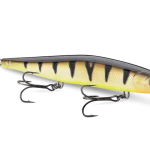
Though the drop shot rig has been popular among expert bass anglers for many years, I still talk to anglers who haven’t tried it, especially those who fish for walleyes and panfish. The beauty of this rig is its simplicity and that you can set your lure or livebait some distance above the bottom.
This makes it more visible to cruising fish or where vegetation like sandgrass covers the bottom. And you don’t have to set the hook, just start reeling and they’re hooked. All you need it a 6 1/2-foot spinning rod and reel spooled with 6- or 8-pound mono. I’m a fan of VMC Spin-Shot hooks, since they prevent line twist; a #2 or #1 for bass and walleyes, #6 for panfish.
I often cast my rig a good distance to work an area of structure. But when you cast, tie the hook farther above your sinker so it stays well above bottom on your retrieve.
I often fish this rig for walleyes on structure in 18 to 24 feet of water, baiting with leeches or ‘crawlers. Cast out and it lands quickly; raise the rod to move it, then give slack; repeat that motion back to the boat. It often outfishes Lindy Rigs or slip-floats in those situations, as you can cover more water and fish particular targets more precisely.
I also drop-shot panfish along deep weedlines, using a small insect imitation. If the big ‘gills get tough, though, a leech or piece of ‘crawler will activate them. You may spot crappies suspended on sonar and you can adjust the hook placement to keep the lure in their zone.
For smallmouth and largemouth bass, drop-shots are unmatched, especially in cover that’s not too thick. In vegetation, I favor a cylindrical sinker since it slides through the stalks easily; on harder bottoms, a round weight is best, since it helps you determine if you’re on rock, sand, or gravel. You can catch bass on a huge variety of small softbaits; it’s hard for fish to pass up. A favorite for largemouths is the tail section a swimming worm with about an inch of the body, skewered on the hook. The action is amazing when you shake it. You can even fish a heavy version of this rig on a bait casting rod with heavier line, dropping lures in thick vegetation. They don’t sink into the bottom and disappear, as can happen with jigs in mucky areas.
In mid and late-summer, this rig is always on my deck, no matter what species I’m after and what type of like I’m on. Gear up and drop in on your favorite spots. You won’t be disappointed!
What are some common sayings and frustrations that walleye fishermen experience, along with preferred setups and deadstick techniques?
Walleye fishermen often find themselves expressing frustrations and sharing common sayings when it comes to ice fishing for these elusive species. The experience can be described as both challenging and rewarding, with anglers facing various hurdles while trying to catch walleyes in frozen waters. One common saying among walleye fishermen is how frustrating the activity can be at times. From dealing with harsh weather conditions to struggling to locate the fish, the pursuit of walleyes can test one’s patience and skills. Despite the challenges, dedicated anglers continue to return to the ice in the hopes of landing these prized catches. In terms of preferred setups and techniques, deadsticking is a popular method employed by walleye fishermen. This technique involves using a stationary rod to present bait to the fish, often complementing more active jigging or trolling techniques. Anglers have their go-to setups for deadsticking, utilizing specific rods, reels, lines, and bait combinations to entice walleyes in icy waters. Overall, walleye fishermen navigate through frustrations and setbacks with determination and passion for the sport. Their experiences and preferences in setup and technique highlight the intricate and rewarding nature of ice fishing for walleyes.
What are some innovative methods for jigging, trolling, and using different baits to target walleye effectively?
Innovative Methods for Targeting Walleye Effectively: When it comes to jigging for walleye, one effective technique is to incorporate a sneaky tweak to your Jigging Rap for enticing those elusive fish. This adjustment can make a significant difference in enticing bites, especially during the fall season. For trolling, consider venturing out at night to use crankbaits to target walleye. Fishing after dark can be challenging but can also yield great results, as walleye are more active during these hours. Using the right crankbaits and techniques can help you land some impressive catches. When it comes to using different baits, rigging big chubs for fall walleye can be a game-changer. Live-bait rigging with large creek chubs and redtails can attract bigger fish and increase your chances of success. Additionally, exploring unconventional bait options like eelgrass can help you target walleye during the mid-day summertime lull. By incorporating these innovative methods into your walleye fishing repertoire, you can enhance your success on the water and potentially reel in some trophy catches.















